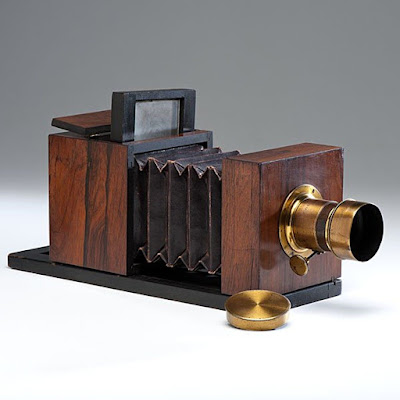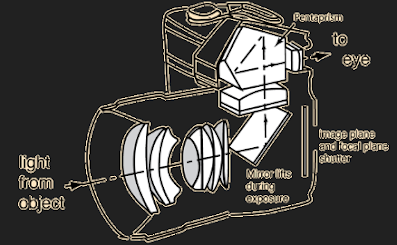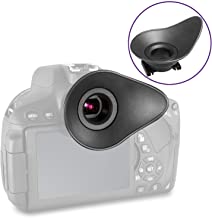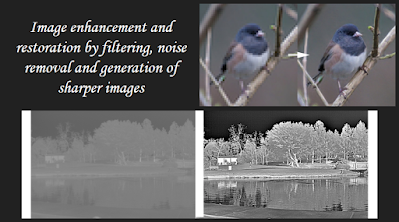How does photography work? All you need to Know!
Photography is an art which has produced immeasurable memories which you hold close to your heart...and the science behind this art is equally paramount!

What can photography be described as?
The word 'Photography' means 'drawing with light'. Light and properties of light play a major role in forming an image.

Photography is the use of physics and chemistry in all its aspects. This includes the camera, its lenses and their operation, and the process of developing images.
Photography isn't just an act of capturing a picture. It is an art of capturing memories that you will reminiscence in the future. These captured memories are split into little pieces of art which we call photographs.
Photography isn't just an act of capturing a picture. It is an art of capturing memories that you will reminiscence in the future. These captured memories are split into little pieces of art which we call photographs.
But, these pieces of art are produced after many complex mechanisms use complex methods to process and form it. What are some of these mechanisms and methods?
Camera
The camera is an electro-mechanical device that uses instruments to capture and store pictures. A camera is a whole unit that has sub-divisions/parts which form it.
For example:
- Lens
- Image sensor
- Aperture
These components and some others will be explained shortly.
Let us look at the history of photography briefly:
Long before cameras were used to capture stills, the first invention was called "Camera Obscura'.Camera Obscura is a Latin phrase meaning 'Darkroom' was a natural optical phenomenon that occurred when the image of a scene is projected through a small hole onto a screen and forms an inverted version of itself.
This was also known as a pinhole camera.
Nicephore Niepce was the first person to create a partially successful photograph sometime around 1816 when he used a small camera of his own making and a piece of paper coated with Silver Chloride, which darkened where it was exposed to light.
But with no means of removing the remaining unaffected silver chloride, the photograph was not permanent, and eventually darkened entirely by the overall exposure to light necessary for viewing it.
After Niepce, his partner Louis Daguerre continued to experiment and created the first practical photographic process and named the 'Daguerreotype'.
But with no means of removing the remaining unaffected silver chloride, the photograph was not permanent, and eventually darkened entirely by the overall exposure to light necessary for viewing it.
After Niepce, his partner Louis Daguerre continued to experiment and created the first practical photographic process and named the 'Daguerreotype'.

How is the film developed?
When the film is exposed to light, it reacts due to the presence of a gelatin emulsion of Silver halide crystals present on its surface.
This reaction causes impressions of the visual as seen by the eye in the form of ghost images to look like x-ray scans and everything is in the form of blacks and whites with different gradients.
Then, the film is dipped into water with temperatures around 20 degrees celsius in order to swell the gelatin layer which then facilitates further development.
The film is then processed in a light-proof tank where ‘Sulfite’ is used as a developing agent and is combined with silver halide present on the surface of the image in order to form black crystals that make up the background of the visual. A clean water bath is substituted after this.
Then, the film is given a stop bath for 10-15 seconds in either acetic acid or citric acid to halt the action of Sulfite or the developing agent.
The next step,
Is where a fixer (often ammonium thiosulfate) makes the image permanent and light-resistant by dissolving the remaining silver halide.
The final step is to wash the image with clean water in order to remove any fixer that remains as a residual fixer may corrode the silver in the image leading to discoloration and fading. The 'photographic' explanation lies below :)
This reaction causes impressions of the visual as seen by the eye in the form of ghost images to look like x-ray scans and everything is in the form of blacks and whites with different gradients.
Then, the film is dipped into water with temperatures around 20 degrees celsius in order to swell the gelatin layer which then facilitates further development.
The film is then processed in a light-proof tank where ‘Sulfite’ is used as a developing agent and is combined with silver halide present on the surface of the image in order to form black crystals that make up the background of the visual. A clean water bath is substituted after this.
Then, the film is given a stop bath for 10-15 seconds in either acetic acid or citric acid to halt the action of Sulfite or the developing agent.
The next step,
Is where a fixer (often ammonium thiosulfate) makes the image permanent and light-resistant by dissolving the remaining silver halide.
The final step is to wash the image with clean water in order to remove any fixer that remains as a residual fixer may corrode the silver in the image leading to discoloration and fading. The 'photographic' explanation lies below :)
Now that we've understood films and their developing process, we shall move onto the first camera ever to actually use films.
The first-ever actual camera was invented by a company known as Kodak led by George Eastman who successfully made the first film camera based on celluloid The invention of paper film at the time made it possible to capture multiple images.
The first-ever actual camera was invented by a company known as Kodak led by George Eastman who successfully made the first film camera based on celluloid The invention of paper film at the time made it possible to capture multiple images.
However, the problem occurred while choosing the medium on which the light-sensitive fragile film was to be rolled around. Initially, John Carbutt, Hannibal Goodwin, and George Eastman started using paper rolls, but they soon realized that the fragile paper rolls weren’t the best for holding films.
Thus celluloid was a class of compounds created from nitrocellulose and camphor, with added dyes and other agents which were chosen because of their easily moldable structures and their non-reactive nature towards films.
Here we can see a contrast between the two types of films:
Thus celluloid was a class of compounds created from nitrocellulose and camphor, with added dyes and other agents which were chosen because of their easily moldable structures and their non-reactive nature towards films.
Here we can see a contrast between the two types of films:
The next few years involved different sizes and types of cameras which used different sizes of films.
An important change during this time was in the system of capturing images.
Two new types, the twin-lens reflex, and single reflex system were introduced. The difference between the two is the connection between the viewfinder and the lens.
The viewfinder is a small glass socket that you use to look at what you're about to capture. In the twin-lens reflex, the viewfinder and the lens are two separate units and you are viewing a higher elevation as compared to what you're going to capture.
Two new types, the twin-lens reflex, and single reflex system were introduced. The difference between the two is the connection between the viewfinder and the lens.
The viewfinder is a small glass socket that you use to look at what you're about to capture. In the twin-lens reflex, the viewfinder and the lens are two separate units and you are viewing a higher elevation as compared to what you're going to capture.
Here's a camera with a twin lens reflex:

But, in a single-lens reflex system, you're viewing EXACTLY what you're going to capture as there are mirrors redirecting the light entering the lens into the viewfinder.
The picture below shows the cross-section of a single-lens reflex system

This has naturally evolved into 'DSLRs' and other electronics-dominated camera types that we see today.
We now move on to parts of a modern camera. A DSLR is what we're considering here.
Formation of an image explained along with parts of a camera:
1. Lens:
The lens is one of the most vital parts of the camera. The light enters through the lens, and this is where the photo process begins. A camera lens is a combination of many lenses and is known as a photographic lens or photographic objective.
There’s no difference in the working principle of these lenses for a still camera, video camera, a telescope or a microscope, or even a smartphone, but their detailed designs and constructions are different.
Compare this to a human eye, in the human eye, light is reflected off an object or surface and passes through the lens, and gets captured on the light-sensitive retina and the brain interprets this with relation to light patterns using rods and cones.
Similarly, in a camera, the light-sensitive surface is the film or a digital light sensor. While in principle a simple convex lens will suffice, in practice, a compound lens is made up of a number of optical lenses to correct scattering of light.
These are called complex lenses and help in better image quality. A lens may be permanently fixed, or it may be interchangeable with lenses of different focal points, lengths, and apertures. Here we can observe the cross-section of a modern DSLR.
There’s no difference in the working principle of these lenses for a still camera, video camera, a telescope or a microscope, or even a smartphone, but their detailed designs and constructions are different.
comparing with the human eye
Compare this to a human eye, in the human eye, light is reflected off an object or surface and passes through the lens, and gets captured on the light-sensitive retina and the brain interprets this with relation to light patterns using rods and cones.
Similarly, in a camera, the light-sensitive surface is the film or a digital light sensor. While in principle a simple convex lens will suffice, in practice, a compound lens is made up of a number of optical lenses to correct scattering of light.
These are called complex lenses and help in better image quality. A lens may be permanently fixed, or it may be interchangeable with lenses of different focal points, lengths, and apertures. Here we can observe the cross-section of a modern DSLR.

2. Focal point and aperture:
Now, what is the focal point? It is the distance at which parallel rays that are incident on the lens are brought to a focus. An aperture is another very important component, it is the opening of the plates of the lens which close and open.
It controls the brightness of the image, or rather the amount of light that passes through the lens and falls on the image sensor. In traditional pinhole cameras, the opening was a pinhole.
But, cameras these days have an aperture of a plate system that can close or open at certain measurements.
It controls the brightness of the image, or rather the amount of light that passes through the lens and falls on the image sensor. In traditional pinhole cameras, the opening was a pinhole.
But, cameras these days have an aperture of a plate system that can close or open at certain measurements.

Much like how the pupil of the human eye dilates in the dark to allow more light to pass through and enables us to see in the dark, as the aperture is increased, we can obtain a greater depth of field in the image.
3. Role of the depth of field in forming an image:
The depth of field for an image is very important as the image mustn’t look like a 2D figure. The depth enables the 3D aspect of the image to be captured onto a 2D surface.
Human beings require 2 eyes to accomplish this task. Here, we can observe that the rocks are in focus and the background is being ignored.
Human beings require 2 eyes to accomplish this task. Here, we can observe that the rocks are in focus and the background is being ignored.

4. Viewfinder:
The next part of a camera is the viewfinder which is a small eye-hole compartment that acts as a mini telescope on the top of the camera to view the whole picture of what you want to capture.

5. Body of a camera:
The body of a camera is the plastic or metal casing into which the whole contraption is put into. Today the smallest camera is the size of a single crystal of salt!
These are used in the field of medicine to capture images from the inside of the human body to detect anomalies.
These are used in the field of medicine to capture images from the inside of the human body to detect anomalies.

6. Shutters and shutter speeds:
Next, we move on to the shutter mechanism in a camera which releases and exposes the light-sensitive material long enough for the image to be captured and creates dramatic effects by either freezing action or blurring motion.
It is one of the three pillars of a good photograph along with aperture and ISO (International Organisation of Standardization).
It is one of the three pillars of a good photograph along with aperture and ISO (International Organisation of Standardization).
When you use long shutter speed, you end up exposing your sensor for a significant period of time causing the frame to blur!
If your shutter speed is long, moving subjects in your photo will appear blurred along the direction of motion.
Landscape photographers intentionally use long shutter speeds to create a sense of motion on rivers and waterfalls, while keeping everything else completely sharp. On the other hand, shutter speed can also be used to do just the opposite – freeze action.
If you use especially fast shutter speed, you can eliminate motion even from fast-moving objects, like birds in flight, or cars driving past.
If you use a fast shutter speed while taking pictures in rain, each droplet will hang in the air completely sharp, which isn't even visible to our own eyes, much like our hummingbird picture!
If your shutter speed is long, moving subjects in your photo will appear blurred along the direction of motion.
Landscape photographers intentionally use long shutter speeds to create a sense of motion on rivers and waterfalls, while keeping everything else completely sharp. On the other hand, shutter speed can also be used to do just the opposite – freeze action.
If you use especially fast shutter speed, you can eliminate motion even from fast-moving objects, like birds in flight, or cars driving past.
If you use a fast shutter speed while taking pictures in rain, each droplet will hang in the air completely sharp, which isn't even visible to our own eyes, much like our hummingbird picture!
The other important effect of shutter speed is on exposure, which relates to the brightness of an image. If you use long shutter speed, your camera sensor gathers a lot of light, and the resulting photo will be quite bright.
By using quick shutter speed, your camera sensor is only exposed to a small fraction of light, resulting in a darker photo. This is where the flash mechanism which is standard on almost all cameras is used. It’s very useful in providing extra light in low-light situations.
By using quick shutter speed, your camera sensor is only exposed to a small fraction of light, resulting in a darker photo. This is where the flash mechanism which is standard on almost all cameras is used. It’s very useful in providing extra light in low-light situations.
We can see a comparison between the two types of shutter speed:
7. Image sensors:
Next, we move on to the image sensor. The image sensor then converts the optical image to an electronic signal and is stored into memory, much like the retinal wall of the human eye which captures the image and sends it to the brain.Depending on whether the sensor is a CCD (Charged coupled device) or a CMOS (Complementary metal-oxide-semiconductor). It will transfer information to the next stage as either a voltage or a digital signal.
We now have the ability to project infrared light using an array of LED illuminators and combined with CCD sensors capable of recording this infrared light, we achieve what is referred to as night vision.
Here's a picture of an image sensor:

8. Storage medium:
In general, cameras use memory or SD cards for storage which are of different sizes and speeds.An example of how photographers have made remarkable advancement:
Harold Edgerton combined the camera with a stroboscope, a device invented in 1831 for studying objects in motion. Edgerton’s device formed the basis for the development of the modern electronic flash, emitted a series of high-speed bursts of light from electrically controlled neon tubes that could record on film a series of stopped-action sequential images.
These extremely short flashes of light overcame the mechanical restrictions of the camera shutter, illuminating events or portions of events as brief as one three-millionth of a second in duration.
It is as if time itself to be chopped up into small bits and frozen so that it suits our needs and captures a series of events in a single frame!
These extremely short flashes of light overcame the mechanical restrictions of the camera shutter, illuminating events or portions of events as brief as one three-millionth of a second in duration.
It is as if time itself to be chopped up into small bits and frozen so that it suits our needs and captures a series of events in a single frame!
Here's how the resultant picture looked:

Your eye can see shades of darkness and bright whites at the same time. Cameras cannot. HDR produces a photo closer to what the eye sees.
Here's an example as to how HDR alters an image:

A small briefing about image processing:
When images were digitized, processing them became a part of a huge industry in computer science. Digital image processing can alter images to something completely different and also create an image from just a few features.
The features we refer to here are distinct parts in the image that are extracted and used as information.
These features are unique to every photograph and are today used to do object detection, image reconstruction, increasing and decreasing the resolution of an image, color filtering and masking, and various such applications.
The features we refer to here are distinct parts in the image that are extracted and used as information.
These features are unique to every photograph and are today used to do object detection, image reconstruction, increasing and decreasing the resolution of an image, color filtering and masking, and various such applications.

Conclusion along with a contrast between professional and non-professional photography:
It makes us wonder then, are smartphones the next generation of DSLRs? Can anyone with a phone become a professional photographer? The key here is the vision of the photographer and his requirements.One cannot shoot the long-range high-resolution photos clicked during a sports event using a smartphone camera. Similarly, it is rather tedious to set up a zoom camera when you are traveling and want to take a quick selfie for a memorial.
I would like to conclude with this thought for the future. All of us have photos we are fond of, memories stored in our phones, or in photo albums. While it is amazing to look at these and reminiscence, it definitely pales in comparison to what the human senses offer in reality.
This is because when we see, we see with all other senses engaged. We feel the warm sunlight or the cold rain touching our skin, we smell the grass in the air, we hear the birds chirping. Maybe with something like the Neuralink.
Maybe the next invention in photography would be to develop photos that would capture the amalgamation of these feelings!
This article was written by Noctural Sushi, a technology enthusiast, and meme lover, and an amazing writer feel free to find him on social media using this link.







![Use Of AI in Our Daily Life [Top 10 Existing Uses]](https://blogger.googleusercontent.com/img/b/R29vZ2xl/AVvXsEg_8o5ggchY3bO9p76AoAgo7yZbR0YXdwxuaJ1ouZhtwOMTZpseWzq97ii1_ocvknpEztRWdVxKXblFvY3Z3LcCh4OJY4zgX-ZrpSQZl4j5onu1xeYFcqpy6LFpNJeGwpbvZRUpUjUlnVqH/w680/AI.jpg)
![Facebook Trying To Beat Discord With Watch Together Feature? [Social Media War Continues]](https://blogger.googleusercontent.com/img/b/R29vZ2xl/AVvXsEiTPDkLA1sEkOEjFOQ1aJGxkq5lPSKwPUGYBzAQxNdh3HEeHH2LAwiMYnnt8mb-0829hiywRTSMgacM_4XhepxGQ9qSWYTKE_OB_9epHOnavJ7GKlPaHi6yfMoZ4bzKtrnaa0VjEJpn87i4/w680/facebook+messgenfer+and+insta+update.png)
0 Comments